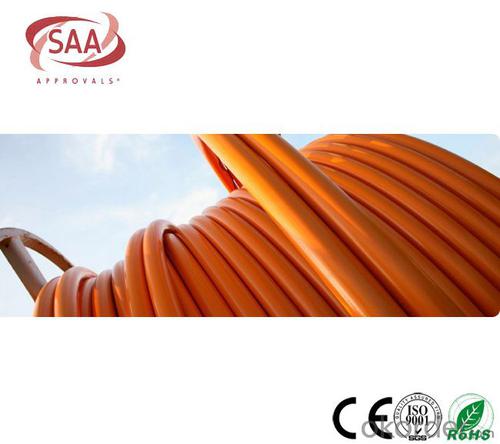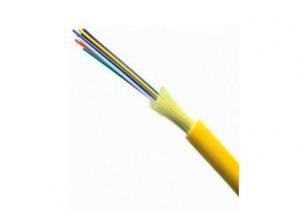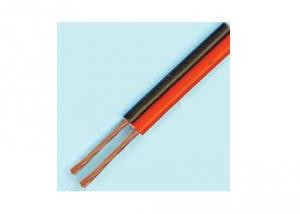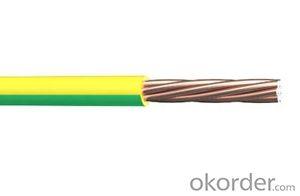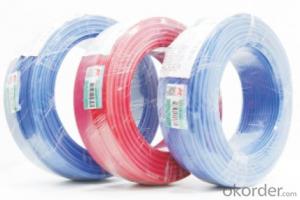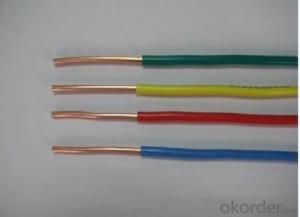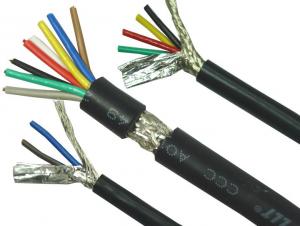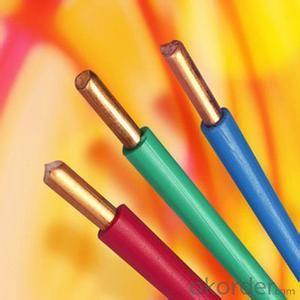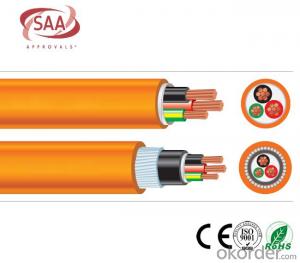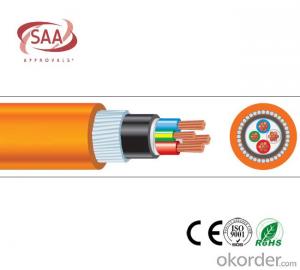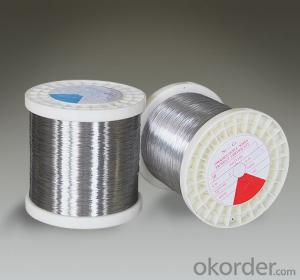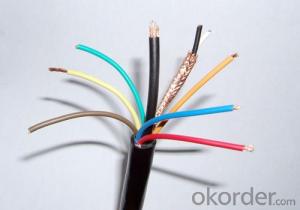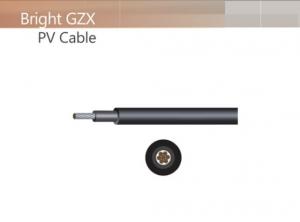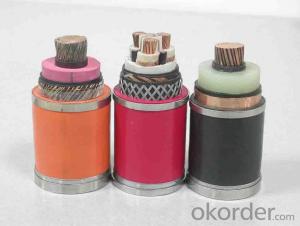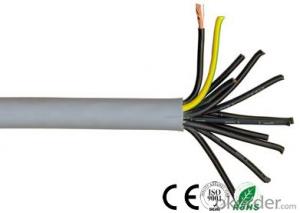Circular Cables PVC 600/1000V 2C+E Copper /Orange cable as per AS/NZS 5000.1
OKorder Service Pledge
OKorder Financial Service
You Might Also Like
Circular Cables PVC 600/1000V 2C+E Copper /Orange cable as per AS/NZS 5000.1
Applications:
For mians, submains and subcircuits unenclosed, enclosed in conduit, buried direct or in underground ducts for building and industrial plants where not subject to mechanical damage. Suitable for glanding.
Rated voltage: 600/1000V
Conductor: Copper 1.5 ~ 95 mm2
Insulation: PVC, V-90. Red, Black & Green / Yellow
sheath: PVC, 5V-90. Orange
Environmental performance: Normal operating temp. 75℃
Standards compliance: AS/NZS 5000.1
Parameter sheet
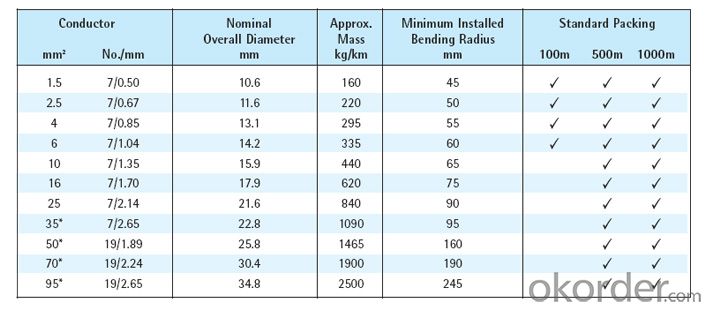

Production facility


Main Quality Inspection Equipment
Sparker tester,Heating aging Chamber,High resistance machine, Oxygen index equipment, Partial discharge inspection instruments, Fireproof testing device,High-power voltage withstand tester,No-rotor Vulkameter,Pull tester,Analytical balance,Direct current bridge,Plastic tester,Projector, Punch machine,Cross-linked cutting machine,etc.

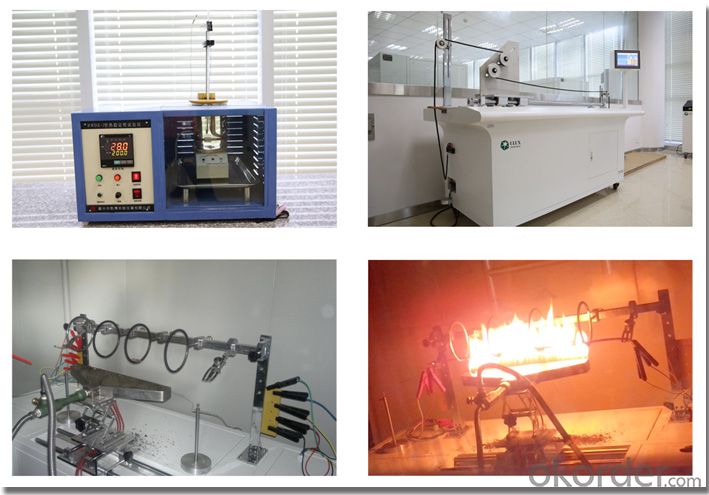
Company Overview





Certificates


- Q: component of electrical wiring system according the appropriate street light. the voltage power supply and herzt(hz) using for street light.
- Too many variables to answer that. In the US we use 60 Hz current. There are several types of lamps to choose from such as Mercury vapor, but I believe most US systems use 240 Vac.
- Q: I have taken out the rotating speaker from an old organ that I wish to externalize to another organ.It has its own transformer (I thinklittle metal-layered box with a wire core in the middle) labeled 115v 60hz. i cut the wires from it that went to the main power supply for the organ. What I am wondering is, can I just solder a plug onto the ends of the power wires and plug it in? Eventually I would install a switch of some sort. Anyhow, because it has the little 115V thingy, how can I plug this thing in?
- Transformers can have extra Output terminals for different voltages. Re-wire yours as per the 1st set-up. You'll need a pwr. switch, altho it can be left energized, as in many devices' pwr. adaptors (which are just glorified transformers, eh? Your plan should work ok (house current is 110v, not 120 or 115, but hey). Hope somebody else can give you better specifics.
- Q: I am trying to change the electrical box to a ceiling fan box. House built in 1959. 4 wires are in the old box 4 white wires are sodered together from 3 of the wires. And one white and 3 black wires are sodered together. I can't take the box out until I cut the wires. What do I do after that? I have a picture I can send.
- Electrical wires should NEVER be soldered. To do so is a violation. You may need to trace these wires to see where they are coming from, but it sounds like the ceiling box was used as some sort of junction for other cables. You might even need to open up the ceiling a little to get room to work. Unless you know what you are doing, it might be better to get an electrician who does. You seem to be interchanging the use of wires to refer to a cable, so you don't sound like you know what you are doing. Get an electrician. You do not want to burn the house down.
- Q: I am experiencing a problem with electrical wiring. I was trying to change a lightswitch to a duplex lightswitch/outlet. I could only get the outlet to work, not the lightswitch part. So I deceided to switch back to my original lightswitch (that originally worked just fine) because I would have to wait for someone who knows more to help me with the duplex. Now the lightswitch doesn't work either. What could have happend to cause this and how do I fix this?
- It sounds like there are pigtails inside the box and one of them came loose. A pigtail is where the main electrical lines come into the box and then there is a shorter piece that it wire-nutted onto that. This shorter piece then goes to the switch or outlet. I would check the connections to see if one of them is loose.
- Q: I am in need of electrical wire at the moment, and i found some old headphones. Would the wire be salvageable to transport small amounts of energy (in a basic device, nothing fancy)?
- In general, no. Depends on the voltage and current. Headphone wires are usually thin and without insulation for high voltages, and may be shielded. small amounts of energy is too vague.
- Q: I plugged in a computer to one of my outlets. I felt current passing through my band as I touched the case and held the monitor Connection and got a big spark when I tried to connect the monitor. This only happens on that outlet.
- It sounds like there is power on the ground wire you can try to use a grounding adapter to break the ground path to see if this helps if that fixes the problem then call a electrician or fix it if you know how. The common and ground should be a separate connection.
- Q: I was wondering if exposed copper wire (and regular wiring) could cause dizziness and headaches.Or could insulating maybe cause it to?
- There is a certain emanation from copper. If you are reacting, it would suggest your system is riding along a very thin line.You have a sensitivity aggravated by an outside source. You have a chronic problem with a part of the nervous system which becomes acute when exposed to that outside source. In this particular instance we refer to the otic (auditory) nerve. If you have no other symptoms then would suggest staying clear of the offending material.If you do have other symptoms then would suggest a visit to your local doctor of Chiropractic and find out what is the causative factor. I just had someone come to see me for the same problem, dizzyness. Only without any factor to cause it. There was found a pronounced structural tenseness which causes several other problems also. She left without the dizzies and even stood much straighter Which seemed to allow much greater depth of breathing.Has asthma also but, is the result of restricted expansion of the chest by that muscular tension.
- Q: Hi everyone, just curious about some different things ive read on the internet, there is 3 switches, 2x2 way and 1xintermediate. in the 1st 2 way coming down from the light, the brown coming down is in l2 with the brown coming up that connects the intermediate switch. the black wire coming up goes into the common in the 2 way switch. in the intermediate it says the grey go in the l1 and l2 and the brown go in the other l1 l2 whilst the black ones are in the connector blocks. i thought it was the grey and black in the l1's and l2's and the browns in connector blocks. thanks for your time to the ones who help :).i have an exam on it tomorrow and thats 1 thing ive read on the internet that i dont think was right.
- The circuit you describe is called a 4 way switch circuit. At the first switch in the circuit the power feed is terminated at the common terminal of the switch and the two travelers ( one red and one black ) of the interconnecting wire connect to the other two terminals. At the center switch of the circuit which is called a 4 way switch ( there can be any number of 4 way switches in a circuit but they must always be in the middle of the circuit ) the input travelers connect to the bright terminal screws and the output travelers connect to the dark terminal screws (typically top-top and bottom-bottom) then at the last switch in the circuit (again a 3 way switch) the travelers connect to the two terminals which are the same color and the output to the light connects to the common terminal. At each switch box the neutral (White) wire is wire nutted to the white wire of the next set of wires. And the bare copper ground wire is both bonded ( Compression bond ) to the ground wire of the next cable AND terminated to the green grounding screw in the box if it is a metal box AND terminated to the green grounding screw on the yoke of the switch.
- Q: How to use the omnipotent amount of electricity leakage of the wire How to check whether the wire leakage
- The bottom of the user's groove and the design of the tail and tail, so that the product will not move firmly at the bottom
- Q: I am installing recessed canister lights in a basement room and I ran into a problem. 3 of the holes that I cut out of the ceiling happened to be right next to several other cables that provide electricity to other parts of the house. The lights in the canisters are 45W R20 bulbs and the canisters themselves are 5 3/8 diameter and will practically touch these lines if I install them in the current holes. Will this canister get hot enough to damage the other wires and cause a dangerous situation or should they be far enough away from the light itself? Also the house is a '91 so the electrical lines should all be 90 c degree temp rating.
- examine to verify if the 2d change controls any of the the precise or backside outlet(s) on the partitions. If no longer, then it would be a existence like job to apply that 2d change to administration your recessed lighting fixtures in case you will get get entry to to the gap above the ceiling and the wall the change is fixed on, so which you would be able to run the twine you will choose. in case you do not have get entry to, this may be extra twine fishing than you desire to handle. additionally examine the set up training for the lighting fixtures and picture doing it without get entry to above the ceiling.
Send your message to us
Circular Cables PVC 600/1000V 2C+E Copper /Orange cable as per AS/NZS 5000.1
OKorder Service Pledge
OKorder Financial Service
Similar products
Hot products
Hot Searches
Related keywords


